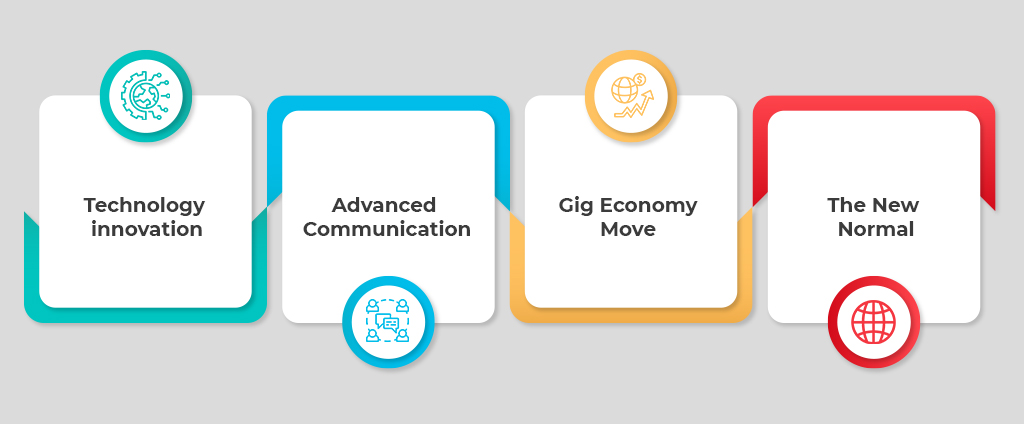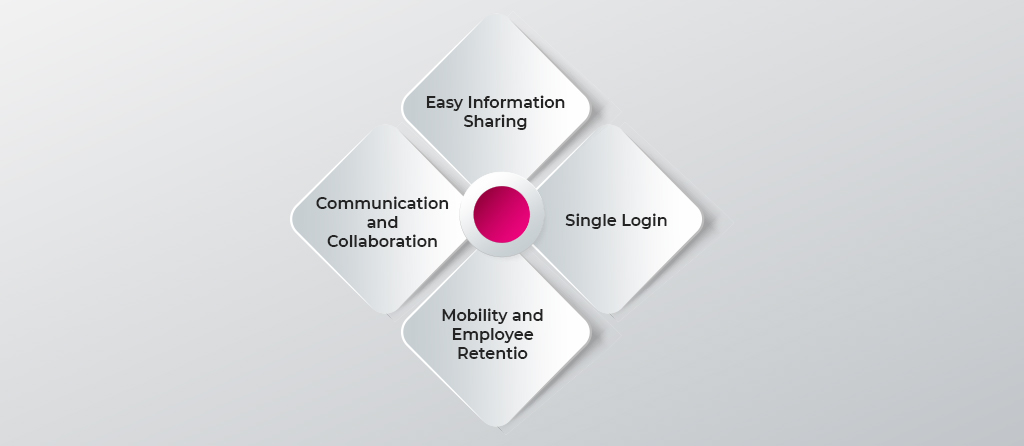The digital workplace is a recent trend that will soon be required in the commercial sector. A Digital workplace gives employees the tools they need to be as productive as possible. It becomes crucial for employees of any company to always be in contact with their coworkers, teams, vendors, partners, and suppliers.
Moreover, it is essential for employees to stay connected, whether they are physically present in the offices or working from a remote location. Digital Workplace gives them the ability to be linked 24/7.
Digital Workplace provides its clients and employees with unparalleled experience by utilizing the physical infrastructure, devices, technologies, and cloud services. As a result, companies see financial benefits from turning their offices into digital workplaces. A digital workplace may also contain an Intranet as a key component to facilitate seamless communication among its employees.
Let us learn in detail about the digital workplace and how an intranet adds value to a digital workplace.
What is a Digital Workplace?
As the term implies, a digital workplace is digitizing your office. Previously, the phrase “digital workplace” was used to refer to word processors, emails, and internet apps all at once. However, the modern digital workplace has grown and now encompasses much more.
It might serve as a virtual office and be made up of different tools and technology that would take the place of a physical workplace. Digital workplaces are cloud-based platforms that give employees access to tools, data, and information on a single platform.
A digital workplace offers employees the flexibility to complete their tasks quickly and effectively from any location at any time.
Additionally, a digital workplace enables its staff to generate data-rich reports, automate administrative activities, and manage projects more effectively. However, the biggest benefit of a digital workplace is that it enables seamless communication between employees working on projects in different departments.
The “digital workplace” is a hub for various tools and technologies, including communication apps, content management systems, knowledge management systems, document storage, sharing platforms, intranet platforms, collaborative toolkits, and much more. Thus, a digital workplace highly eases the employees’ tasks, resulting in their performance.
What is an Intranet?
An Intranet is a private network that communicates effectively with a company’s employees. An intranet is a secure application that authorizes employees’ knowledge sharing and collaboration access. Previously, Intranet was just an information repository containing links to resources. However, with technological advancement, intranets have become a modern communication and collaboration platform.
An Intranet becomes an integral part of a digital workplace as it is a central platform for employees’ communication. It serves as the employees’ single point of access to company information and updates.
A modern intranet keeps workers interested and promotes efficient communication. Additionally, online training programs support employees’ growth and task performance. Consequently, it serves as a digital hub for businesses, assisting their development, , what are intranets explained by Reworked.
Why is it essential to create a Digital Workplace and how does an Intranet fit in?
What would your workplace look like if you arrived there ten years ago? Technology will undoubtedly impact how work is done and what constitutes a workplace. The transformational journey of the digital transition is already underway.
The digital workplace is one of the steps toward the future of the business. Innovation on a large scale is flourishing, and companies are highly interested in funding projects that may boost operational effectiveness, simplify administrative procedures, and draw in the best personnel.
Let us examine in detail the four key ways digital technologies are changing our operations.

Technology Innovation:
Technology has come a long way, from 5G technology to machine learning and robotic surgeries. Exceptional digital tools have been successful in speeding up work and eliminating menial duties.
Advanced Communication:
The way we communicate has changed significantly. From WhatsApp videos to Instagram reels and Zoom meetings, people today are more communicative. Additionally, this changeover has spawned a variety of communication software that enables businesses to link their dispersed employees and facilitate effective collaboration.
Gig Economy Move:
Companies now find it more challenging than ever to hold onto their top talent due to the shift of workers toward the gig economy and freelancing. Digital workplaces assist businesses in these situations by facilitating the use of remote workers and maximizing their productivity.
The New Normal:
Covid times have made companies realize the importance of working from home. Post-Covid, WFH employees and a hybrid workforce has become a ‘new normal.’ This new normal has made the digital workplace more pivotal than ever.
As per a report from International Data Corporation, 55% of small businesses have already adopted the digital strategy, and 38% of traditional companies have already gone digital. Even more, a report from Grand View Research states that the global Digital Workplace Market size in 2021 was valued at USD 27.33 billion and is expected to grow at a Compound Annual Growth Rate of 22.33% from 2022 to 2030.
This study marks the importance of the digital shift and answers the above question of why it is crucial to create a digital workplace.
Should Intranet be a part of your Digital Workplace?
Well, this question arises in everyone’s mind when we talk about a digital workplace. And the answer is simply a ‘Yes.’ A digital workplace’s Intranet serves as its center for internal collaboration. It is an essential tool that links workers to the locations, regulations, and other professionals required to complete their work more efficiently. It serves as a central hub for connecting, working together, learning, and accessing information for employees. An intranet encourages employees to uphold the company’s mission.
Employees can use the Intranet to connect as well as troubleshoot minor issues with the use of video courses and self-help manuals. It enables rapid access to frequently used applications and encourages users to take advantage of online training resources made available by platforms.
Additionally, an intranet supports workplace platforms and technology to meet the demands of enterprises with strong digital connections. So, if you want your office to remain connected and active, an intranet should be a key component of your digital workplace.
How does an Intranet function in a Digital Workplace?

We have already learned about the digital workplace and its crucial intranets. In this part, let us study the function of an intranet in the modern workplace. So, as we are all aware, the evolving digital workplaces have been facilitated by technologies like artificial intelligence (AI), big data, cloud computing, and low-code process automation. And the integration of these technologies forms the foundation of a contemporary intranet.
An intranet has established itself as the hub of communication and collaboration for a company’s workplace strategy in the context of remote working. Through the following, it has evolved into the cornerstone of a well-designed digital workplace:
Communication and Collaboration:
Social Intranet features like emails, project management, leave management, instant messaging, etc. help various departments like HR, Accounts, Sales, and even technical departments to communicate effortlessly. Intranet collaboration software helps improve communication among departments and remote workers and binds them into one unit.
Easy Information Sharing:
A successful digital workplace is one where employees can conveniently and promptly access information. A successful intranet is a hub for collaboration in the digital workplace where users can quickly access papers, study materials, reports, videos, and presentations. This not only saves time but also boosts worker effectiveness.
Single Login:
The Intranet is integrated with various tools and applications, allowing users to access these tools and applications with a single sign-on. It serves as a gateway into a larger digital workplace, saving time and effort in the process.
Mobility and Employee Retention:
Covid has emphasized the significance of mobility, and today’s workers are at ease working from distant locations. Here, intranets have been crucial in integrating remote workers into the business. The portal makes it simple for employees to access the latest news, guidelines, jobs, events, functions, and announcements, keeping them informed and involved. This keeps them around and aids in their growth, as well as keeps them rooted in positive business culture.
Combined, an intranet within a digital workplace offers an unparalleled employee experience that helps the teams to stay coordinated and get work done faster and better.






